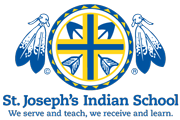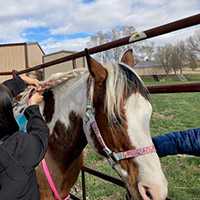Home » Native American Youth Programs » Mental Health » Equine Therapy at St. Joseph’s Indian School
Equine Therapy at St. Joseph’s Indian School
To the Lakota, a šúŋkawakȟán — horse — is a four-legged friend and companion that provided transportation, friendship and pride. The horse is revered for its grace and bravery.
Today, many Lakota people still look to the horse to provide healing from trauma, anxiety, and mental and emotional distress, among others.
Healing from internal or external wounds was the purpose behind launching the Equine Therapy program at St. Joseph’s Indian School.
Where do the horses live?
In the beginning, horses were transported to and from campus for therapy sessions. Now, horses live on the north end of campus, creating the opportunity for more students to take part in the equine therapy sessions.
The horses roam across 50 acres of fenced grassland on St. Joseph’s campus. However, they are brought back together to assist in therapy, guidance classes and azílya — purification — with staff and students (more commonly known as smudging).
The horses reside in St. Joseph’s Equine Therapy Center, which was completed in the spring of 2023 thanks to the very generous donations of our supporters from around the world. The center includes a riding arena, classroom and office space, an observation deck, stables and more!
What makes this program special?
The program has been very successful and students have been very receptive to it. Partly because the horse listens and makes no judgements. It feels the pain and soothes St. Joseph’s students — its relatives — and offers silent help.
“Students have the opportunity to connect with the horses through counseling sessions as well as guidance class. Horses are very in-tune to body language — this is beneficial to the students because horses respond at a sacred level. Students feel connected spiritually and have opportunities to overcome challenges through means other than talk therapy,” said Robyn, Director of Counseling Services.
It can be difficult for little ones to be away from home — especially when they are first year students. Having the comforting presence of a horse can be truly beneficial.
“I learned that horses are nice animals,” said one student. “You can have conversations with the horses. It is okay to tell horses anything because they can’t tell anyone.”
As children learn to open-up to the horses and feel the positive effects of that relationship, they will be more inclined to open-up to people.
Meet Our Horses
The Equine Therapy horses at St. Joseph’s Indian School are very special. Just as children arrive at St. Joseph’s with a variety of obstacles to overcome, so have these horses weathered their own battles. Many of the horses are rescue animals that needed special training, care and patience. Knowing the horses have gone through hardships makes them that much more relatable to some of the children benefitting from the program.
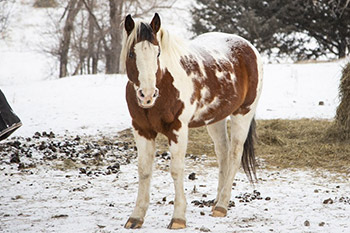
Cochee
Cochee is a Paint gelding. When Patty, the St. Joseph’s equine specialist, started working with Cochee, he wanted nothing to do with adults. He was very hard to catch and had trust issues. However, little by little he started coming around. Students at St. Joseph’s sometimes come to school with those same issues. He is wonderful at reading body language and helping students work through these obstacles.
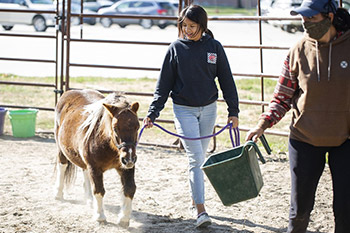
Pony Boy
Pony Boy is a gelded Paint miniature pony. Although he might be small in stature, he makes up for it with his giant heart. He can light up any face he meets and he is so gentle.
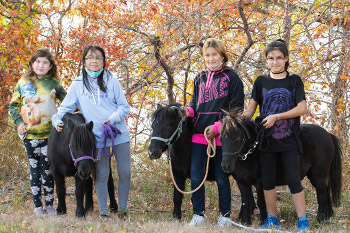
Violet and Blue
Violet is a black mare and Blue is black gelding.
Before Violet was rescued and brought to St. Joseph’s, she lived in a chicken coop with poor living conditions. Violet has a lung condition (presumably from living in the chicken coop) that makes her a little slower than the average horse. But she is loved immensely by the children. Blue arrived with some manners that needed taming, but has come a long way.
Both are as sweet as can be! Having small horses on campus is very beneficial, as younger students find them less intimidating.
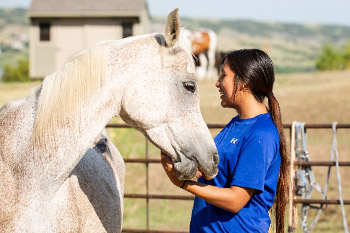
Gramma
Gramma is a white Arabian mare that was rescued from Lower Brule, S.D. She had no water and all her hair was gone. Flies covered her entire body. When Patty, St. Joseph’s equine specialist, found her, she thought she was dead. She and others worked quickly to save her. They placed Gramma in a barn to recover, and gave her proper care.
With time, Gramma flourished. She foaled in April 2020, and delivered her baby — a girl named Willow.
Gramma loves all, but her heart is with the kids at St. Joseph’s. Her favorite treats are red apple slices and carrots. She has a kindness displayed in her eyes.

Willow
The newest addition to the St. Joseph’s Equine Therapy program is Willow! Gramma gave birth to her June 2021. Willow is already proving to be a curious little thing and we can’t wait to watch more of her personality develop and unfold.
Is there a cultural connection between Native Americans and horses?
Yes! The šúŋkawakȟáŋ — horse — is a relative to the Lakota. For centuries, there has been a special kinship between the horse and Lakota people.
Read more about The Horse
Tell me more about how St. Joseph’s incorporates horses on campus!
Creating positive experiences for students that include animals is important. The horses, while primarily here to provide support through Equine Therapy, also take part in multiple events on campus. You can read more about the horses and the impact they make in the following stories.
